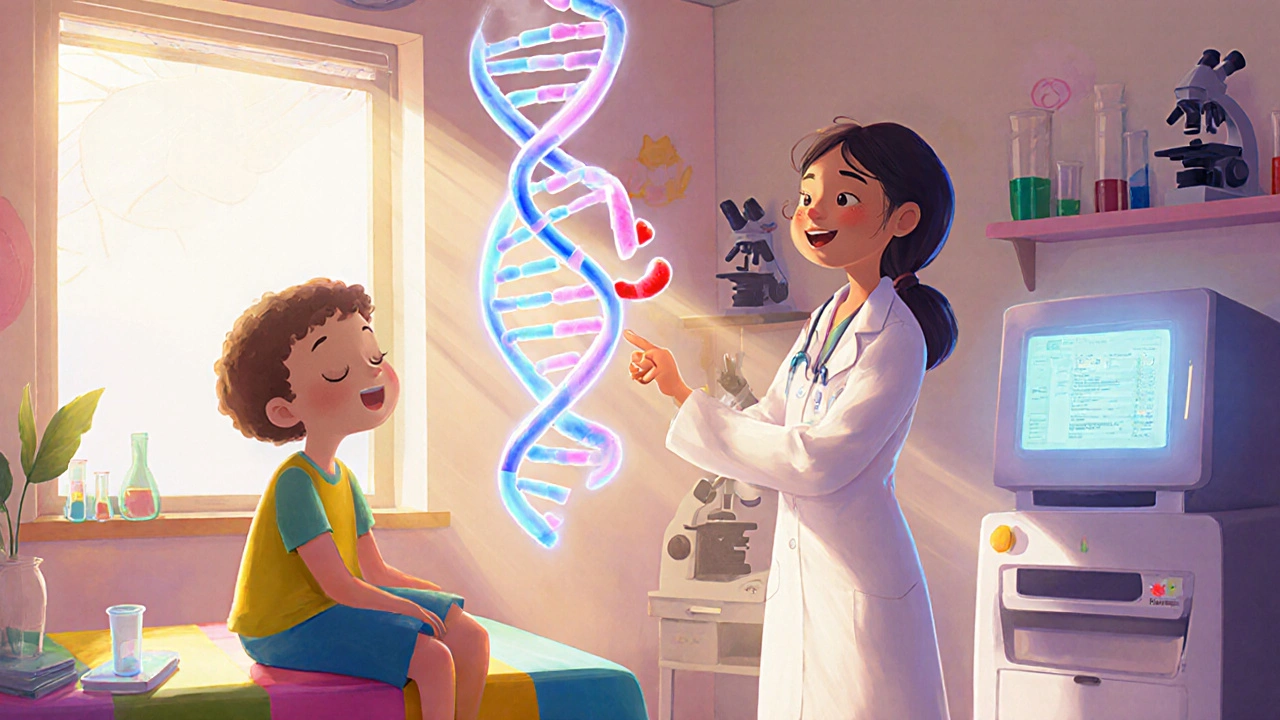ALL Treatment Options Comparison
Compare key characteristics of treatments for chromosome-positive lymphoblastic leukemia. Select up to 3 treatment options to see a side-by-side comparison of efficacy, side effects, and practical considerations.
Select Treatment Options
Choose up to 3 treatments to compare
Treatment Comparison
When a patient receives a diagnosis of Chromosome-Positive Lymphoblastic Leukemia is a subtype of acute lymphoblastic leukemia (ALL) characterized by specific genetic rearrangements such as the Philadelphia chromosome (BCR‑ABL1) or other fusion genes. These rearrangements drive rapid cell growth and make the disease harder to treat with conventional chemotherapy alone. Over the past decade, researchers have shifted from a one‑size‑fits‑all approach to precision‑driven regimens that directly target the underlying genetics. This article walks through the most promising therapies on the horizon, how they work, and what patients can realistically expect in the next few years.
Why Genetics Matter in ALL
Chromosomal translocations act like broken switches that keep leukemia cells in an “always‑on” growth mode. The classic example is the Philadelphia chromosome, which fuses the BCR gene on chromosome 22 with the ABL1 gene on chromosome 9, creating a tyrosine kinase that fuels proliferation. Identifying these changes early-using Next-Generation Sequencing or RT‑PCR-allows clinicians to match patients with drugs that block the offending pathway.
Current Standard of Care
Today's backbone still includes intensive multi‑agent chemotherapy combined with a tyrosine‑kinase inhibitor (TKI) for Philadelphia‑positive patients. While survival rates have improved from under 30 % in the 1990s to roughly 70 % today, relapse remains a major concern, especially for high‑risk genetic profiles. Allogeneic stem‑cell transplantation (allo‑SCT) is often reserved for those who fail to achieve deep molecular remission.
CAR‑T Cell Therapy: Re‑engineering the Immune System
Chimeric Antigen Receptor T‑cell (CAR‑T) therapy takes a patient’s own T‑cells, inserts a gene that codes for a receptor targeting a leukemia‑specific antigen (most commonly CD19), and reinfuses the modified cells. The result is a living drug that can hunt down and destroy malignant cells.
- Mechanism: Synthetic receptor binds CD19, triggering T‑cell activation and cytokine release.
- Clinical evidence: The phase II trial ZUMA‑3 (2023) reported a 73 % complete remission (CR) rate in adult ALL, including many with high‑risk cytogenetics.
- Challenges: Cytokine release syndrome (CRS) and neurotoxicity; manufacturing lead times of 2-3 weeks.
Newer constructs aim at dual antigens (CD19 + CD22) to prevent antigen‑loss relapse. Early data from the PACT‑12 study suggest that 85 % of patients remain in CR at 12 months.
Bispecific T‑Cell Engagers (BiTEs): Plug‑and‑Play Immunotherapy
Bispecific antibodies bring a patient’s T‑cells into direct contact with leukemia cells by binding CD3 on T‑cells and CD19 or CD22 on blasts. Unlike CAR‑T, BiTEs are off‑the‑shelf and can be administered repeatedly.
- Example: Blinatumomab (CD19‑BiTE) received FDA approval in 2022 for MRD‑positive ALL.
- Efficacy: In a pooled analysis of three phase III trials, blinatumomab achieved a 57 % MRD‑negative rate after two cycles.
- Side‑effects: Similar CRS profile to CAR‑T, but usually milder; continuous infusion required.
Next‑generation BiTEs targeting CD22 (e.g., teclistamab) are in phase I/II studies and show activity even after CD19‑directed failures.

Targeted Small‑Molecule Inhibitors
Beyond TKIs for BCR‑ABL1, a wave of novel inhibitors is addressing other pathways that keep leukemia cells alive.
| Agent | Primary Target | Clinical Phase | Key Findings |
|---|---|---|---|
| Asciminib | BCR‑ABL1 myristoyl pocket (STI‑571 resistant) | Phase III | 30 % deeper molecular responses vs. imatinib in Ph+ ALL. |
| Venetoclax | BCL‑2 anti‑apoptotic protein | Phase II | CR rate 45 % when combined with low‑dose chemotherapy. |
| Idelalisib | PI3Kδ isoform | Phase I/II | Potential synergy with TKIs; manageable toxicity. |
| Dasatinib‑prodrug (LD‑100) | Broad BCR‑ABL1 and SRC family kinases | Phase I | Improved CNS penetration; early responses in CNS‑relapsed ALL. |
These agents often pair with immunotherapies, creating a “double‑hit” strategy that attacks leukemia on two fronts.
Gene‑Editing Frontiers: CRISPR‑Based Approaches
CRISPR‑Cas9 can excise the BCR‑ABL1 fusion at the DNA level, offering a potential cure rather than control. Pre‑clinical models demonstrate successful deletion of the oncogenic transcript in patient‑derived xenografts, with no off‑target effects detectable after deep sequencing.
- Delivery: Lipid nanoparticles (LNPs) or ex vivo edited hematopoietic stem cells.
- Current status: The first-in-human Phase I trial (CRISPR‑ALL‑01) is recruiting in 2025, aiming for a safe dose that achieves >70 % editing efficiency.
- Risks: Immune response to Cas9 protein; long‑term surveillance needed for chromosomal rearrangements.
If successful, CRISPR could eliminate the need for lifelong TKIs and reduce transplant‑related complications.
Monitoring Minimal Residual Disease (MRD) with Next‑Gen Tools
Advanced MRD detection now uses Next-Generation Sequencing panels that can spot one leukemic cell among 100,000 normal cells. Early MRD negativity correlates with a 90 % chance of long‑term remission, regardless of the treatment modality.
Emerging digital PCR platforms promise same‑day results, enabling clinicians to adapt therapy in real time-escalating to CAR‑T or a second‑generation BiTE if MRD re‑appears after a TKI course.

Putting It All Together: A Practical Treatment Roadmap
- Genetic profiling at diagnosis: Identify Philadelphia chromosome, other fusions, and mutation burden using NGS.
- Induction therapy: Combine pediatric‑style multi‑agent chemotherapy with a TKI (imatinib, dasatinib, or asciminib) for Ph+ cases.
- MRD assessment (Day 28): If MRD < 0.01 %, continue current regimen; aim for MRD‑negative status before consolidation.
- High‑risk MRD‑positive patients: Consider early integration of immunotherapy-CAR‑T (if donor T‑cells are available) or BiTE (blinatumomab) as bridge to transplant.
- Relapse after TKI: Switch to a next‑generation inhibitor (asciminib) or add venetoclax‑based chemo‑free regimen.
- Eligibility for CRISPR trial: Offer to patients with persistent BCR‑ABL1 after all other options, provided they meet safety criteria.
- Long‑term follow‑up: Quarterly MRD checks; monitor for late toxicities from CAR‑T (B‑cell aplasia) or transplant (GVHD).
This algorithm isn’t set in stone-clinical judgment and patient preference always shape the final plan. However, it captures the shift from “chemo‑only” to a multi‑modal, genetics‑driven paradigm.
What Patients and Families Should Ask Their Doctors
- Which specific chromosomal abnormality does my child have?
- Are there clinical trials for CAR‑T or next‑gen TKIs that I qualify for?
- How do we interpret MRD results, and how often will they be measured?
- What are the long‑term side‑effects of immunotherapy versus transplant?
- Is gene‑editing therapy an option in the near future?
Having clear answers helps set realistic expectations and reduces the anxiety that comes with a leukemia diagnosis.
Future Outlook
By 2030, experts predict that more than half of chromosome‑positive ALL patients will achieve MRD‑negative remission without ever receiving an allo‑SCT. The key drivers will be:
- Wider availability of off‑the‑shelf bispecifics that can be used as first‑line consolidation.
- Improved CAR‑T manufacturing pipelines reducing time-to-infusion.
- CRISPR‑based curative approaches moving from trial to standard care.
The landscape is already shifting, and staying informed about each new option is essential for patients, families, and clinicians alike.
Frequently Asked Questions
What makes chromosome‑positive ALL different from other ALL types?
The presence of specific genetic rearrangements, such as the Philadelphia chromosome, creates a distinct biological driver that can be directly targeted with drugs like TKIs, unlike standard ALL where treatment relies more heavily on chemotherapy alone.
Is CAR‑T therapy curative for chromosome‑positive ALL?
CAR‑T can induce deep, durable remissions in many patients, but long‑term data are still emerging. Some patients remain disease‑free for years, while others may need a transplant after CAR‑T if the leukemia returns.
How do bispecific antibodies differ from CAR‑T cells?
Bispecifics are off‑the‑shelf proteins that redirect a patient’s existing T‑cells to the leukemia, while CAR‑T cells are patient‑derived T‑cells genetically engineered to express a synthetic receptor. Bispecifics are given continuously, whereas CAR‑T is a single infusion.
Can I enroll in a CRISPR‑based clinical trial?
Trials are currently open for adults with relapsed or refractory Ph+ ALL who have exhausted standard options. Eligibility depends on age, organ function, and absence of prior gene‑editing exposure.
How often should MRD be measured after treatment?
Guidelines recommend MRD testing at the end of induction, after consolidation, and then every 3-6 months for the first two years. More frequent checks may be needed if a patient receives CAR‑T or a BiTE.

Albert Fernàndez Chacón
October 18, 2025 AT 14:09The shift toward targeted immunotherapies like CAR‑T and BiTEs really changes the treatment landscape. While TKIs remain a backbone for Ph+ ALL, integrating a CD19‑directed approach can boost MRD negativity rates. In practice, I’ve seen patients move from standard chemo to a single infusion of CAR‑T and achieve deep remission. The key is early genetic profiling so the right modality is chosen. Also, balancing toxicity-especially cytokine release syndrome-requires vigilant monitoring. Overall, the data suggest a move away from transplant in many cases.
Rajesh Singh
October 22, 2025 AT 01:29One cannot sit on the sidelines while a life‑saving breakthrough looms on the horizon. It is a moral imperative that physicians rush to incorporate CAR‑T and BiTEs into their protocols, rather than clinging to antiquated chemo‑only regimens. The evidence is crystal clear: patients achieve remission faster and endure fewer long‑term side effects. Delaying such care borders on negligence, especially when the technology is already FDA‑approved.
Drew Waggoner
October 25, 2025 AT 12:49Reading about these advances feels bittersweet-hope mingles with the weight of relentless disease. The promise is undeniable, yet the shadows of uncertainty linger.
Mike Hamilton
October 29, 2025 AT 00:09In the grand tapestry of medicine, each new thread-be it a kinase inhibitor or a gene‑editing tool-adds colour to a story older than any single disease. It's fascinating how cultures across the world adopt these therapies at different paces, often shaped by local healthcare philosophies. Yet, we must ask ourselves: are we chasing innovation for its own sake, or truly lifting the burden of suffering? The answer, perhaps, lies in a balance between science and humanity.
Alex Lineses
November 1, 2025 AT 11:29For clinicians stepping into the arena of chromosome‑positive ALL, think of the therapeutic arsenal as a modular toolkit. Begin with a robust NGS panel to pinpoint the fusion, then layer a second‑generation TKI such as asciminib to suppress BCR‑ABL1 activity. If MRD persists, transition to a CD19‑directed CAR‑T construct or a BiTE like blinatumomab to eradicate residual blasts. Throughout, maintain dose‑adjustments based on hepatic and renal function, and ensure prophylactic antivirals to mitigate viral reactivation during immunotherapy. This stepwise approach harmonizes efficacy with safety, giving patients the best chance at durable remission.
Brian Van Horne
November 4, 2025 AT 22:49Indeed, the convergence of genomics and immunotherapy heralds a new epoch in ALL care.
Karla Johnson
November 8, 2025 AT 10:09The relentless march of scientific discovery in chromosome‑positive acute lymphoblastic leukemia demands our unwavering attention, for each breakthrough reshapes the therapeutic horizon. First, the integration of next‑generation sequencing at diagnosis empowers clinicians to stratify patients with unprecedented precision, identifying BCR‑ABL1 fusions and rarer translocations that dictate treatment pathways. This molecular insight directly informs the selection of tyrosine‑kinase inhibitors, where first‑generation agents like imatinib have given way to more potent successors such as dasatinib, nilotinib, and the myristoyl‑site binder asciminib. Clinical trials consistently demonstrate that patients achieving deep molecular remission-often defined as a >3‑log reduction in BCR‑ABL1 transcripts-experience markedly improved overall survival. Yet, the story does not end with kinase inhibition; the advent of chimeric antigen receptor T‑cell therapy has introduced a living drug capable of seeking out CD19‑positive blasts with surgical precision. Data from the ZUMA‑3 and PACT‑12 studies reveal complete remission rates exceeding 70 %, even among individuals harboring high‑risk cytogenetic profiles. Nonetheless, clinicians must remain vigilant for cytokine release syndrome and neurotoxicity, adopting step‑wise mitigation strategies such as tocilizumab and corticosteroids when necessary. Parallel to CAR‑T, bispecific T‑cell engagers like blinatumomab and emerging CD22‑directed agents provide an off‑the‑shelf alternative that can be administered continuously to sustain MRD negativity. The convenience of an off‑the‑shelf biologic eliminates the manufacturing delays inherent to autologous cell products, thereby reducing the window during which leukemic proliferation could recur. Moreover, small‑molecule inhibitors targeting BCL‑2 (venetoclax) and PI3Kδ (idelalisib) are forging synergistic partnerships with immunotherapies, attacking leukemic survival pathways from multiple angles. In a similar vein, CRISPR‑based gene editing endeavours aim to excise the pathogenic BCR‑ABL1 fusion at its genomic root, offering a potential curative modality that could obviate lifelong TKI dependence. Early‑phase trials employing lipid nanoparticle delivery have achieved editing efficiencies surpassing 70 % in xenograft models, with safety profiles that appear acceptable thus far. However, the specter of off‑target effects and immune responses to Cas9 necessitates rigorous long‑term surveillance before such approaches can be mainstreamed. From a practical standpoint, an algorithmic treatment roadmap begins with comprehensive genetic profiling, proceeds to induction with a pediatric‑style chemotherapy backbone plus a TKI, and escalates to immunotherapy upon MRD positivity. Subsequent consolidation may involve transplant for those failing to achieve MRD negativity, although the goal is increasingly to replace transplant with CAR‑T or BiTE‑based regimens. In conclusion, the confluence of targeted small‑molecule inhibitors, cellular therapies, and genome editing heralds an era where the once‑grim prognosis of chromosome‑positive ALL can be transformed into a chronically manageable, or even curable, condition.
Matthew Miller
November 11, 2025 AT 21:29Karla, your deep dive captures the excitement in the field! Every new trial feels like a bright spark lighting the path for patients who once faced bleak odds. Keep riding this wave of innovation-your insight fuels hope across the community!
Margaret pope
November 15, 2025 AT 08:49Karla you outlined a solid roadmap and the detail is helpful great job
Linda A
November 18, 2025 AT 20:09The pursuit of a cure, as you described, mirrors humanity's endless quest to rewrite its own story; yet we must temper ambition with humility, remembering that each intervention writes a new chapter in a patient's lived experience.
Joe Moore
November 22, 2025 AT 07:29Yo karla, all this hype about CAR‑T and CRISPR feels like the big pharma’s newest distraction, ya know? They’re pushing expensive tech while keeping the old chemo machine rolling, keeping profits sky‑high.
Emma Williams
November 25, 2025 AT 18:49I see your point Joe we all want real progress not just hype lets keep pushing for transparent trials and patient‑centered data
Stephanie Zaragoza
November 29, 2025 AT 06:09While enthusiasm is commendable, it must be balanced with rigorous scrutiny, especially when claims of curative potential dominate headlines; the data, although promising, remain preliminary, and without long‑term follow‑up we risk overpromising patients, clinicians, and stakeholders alike.
Liberty Moneybomb
December 2, 2025 AT 17:29The shadows behind these ‘breakthroughs’ are deeper than we’re told; every so‑called miracle carries a hidden agenda, and the ordinary patient is left to navigate a maze of secret trials and undisclosed side‑effects while the powers that be watch from their ivory towers.